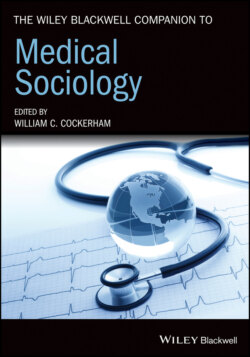Читать книгу The Wiley Blackwell Companion to Medical Sociology - Группа авторов - Страница 25
TALCOTT PARSONS AND EMILE DURKHEIM
ОглавлениеFrom 1946 to 1951, the new field of medical sociology was almost completely an applied area of research. Medical sociologists worked with psychiatrists and other physicians on government-funded projects to largely address medical problems; few were employed in university departments of sociology in the US and they were generally absent from sociology faculties in Europe and Asia. However, a pivotal event occurred in 1951 that oriented medical sociology toward theoretical concerns and initiated the establishment of its academic credentials. This was the publication of Talcott Parsons’ long anticipated book, The Social System, which established the author at the time as the dominant figure in American sociology. Anything Parsons published attracted great attention because he was thought to be charting a course for all of sociology. This book, providing a structural-functionalist model of society, contained Parsons’ concept of the sick role and was the first time a major sociological theorist included an analysis of the function of medicine in a general concept of society. Parsons (1951: 428–9) was interested in the differing roles of professionals in capitalist and socialist societies and decided to include physicians and their relationship to their clients in his analysis because this topic was an area of long-standing interest and one in which he felt he had familiarity.
Parsons had been strongly influenced by the ideas of the classic sociological theorists Emile Durkheim and Max Weber. He had completed his doctoral studies at Heidelberg University in Germany in the mid-1920s where he participated in the “Weber Circle” that continued to meet regularly to discuss sociology at the home of Max Weber’s widow, Marianne Weber, following Weber’s death in 1920. Parsons subsequently translated Weber’s book on the Protestant Ethic and the Spirit of Capitalism (Weber [1904–5] 1958) into English, and reintroduced the theoretical work of both Weber and Emile Durkheim to European sociologists after the disruption of their work during World War II. In his concept of the sick role, Parsons incorporated Durkheim’s ideas on moral authority and Weber’s analysis of religion into his discussion of the normative requirement to visit physicians when sick and the dominant position of the physician in the doctor–patient role relationship.
Parsons’ concept of the sick role is a clear and straightforward statement of four basic propositions outlining the normative pattern of physician utilization by the sick and their respective social roles. Parsons not only constructed the first theoretical concept directly applicable to medical sociology, but by utilizing the work of Durkheim and Weber, he did so within the parameters of classical sociological theory. His formulation was recognized as “a penetrating and apt analysis of sickness from a distinctly sociological point of view” (Freidson 1970a: 228), which indeed it was. Parsons’ concept of the sick role remained a central theoretical proposition in medical sociology for decades, despite challenges. It still survives in a diminished status as an “ideal-type” explanation for physician–patient encounters in which the primary form of interaction is that of guidance on the part of the physician and cooperation by the patient in clinics or office settings.
Parsons also influenced the study of professions by using the medical profession as the model for professions based on expertise and a service orientation. Although extensive criticism was to subsequently lessen the acceptance of the Parsonian approach to theory, this outcome does not negate the significant influence Parsons initially had on promoting theory in medical sociology. Parsons, more so than any other sociologist of his time, made medical sociology academically viable by providing it with its inaugural theoretical orientation: structural-functionalism.
However, structural-functionalism, with its emphasis on value consensus, social order, stability, and functional processes at the macro-level of society, had a short-lived period as the leading theoretical paradigm in all of sociology, including medical sociology. It was under assault by critics in the 1960s and early 1970s and lost influence thereafter. Symbolic interactionists had objected to the relegation of individuals to passive roles in large social systems, while conflict theorists found structural-functionalism inadequate in explaining the process of social change and the social functions of conflict. The theory’s emphasis on equilibrium and consensus also seemed to favor maintenance of the status quo and support for dominant elites. No one calls themselves a structural-functionalist today.
Durkheim ([1895] 1964), however, who was initially responsible for the theory in sociology, remains one of the greatest sociologists of time through his efforts to establish sociology as a science based on methodological procedures and empirical data. He emphasized the importance of macro-level social processes, structures, norms, and values external to individuals that integrated them into the larger society and shaped their behavior. People were depicted as constrained in exercising free will by the social order. Durkheim’s ([1897] 1951) only work that had a direct application to medical sociology was his theory of suicide in which the act of taking one’s life was determined by the individual’s ties to his or her community or society. This is seen in his typology of three major types of suicide: (1) egoistic (social detachment), (2) anomic (state of normlessness), and (3) altruistic (a normative demand for suicide). A fourth type, fatalistic suicide, was never fully conceptualized. The merit of his approach is that it shows the capability of the larger society to create stressful situations where people are forced to respond to conditions not of their own choosing. Thus, Durkheim helps us not only to understand the social facets of suicide, but also to recognize that macro-level social events (like economic downturns) can affect health in a variety of ways through stress and that the effects of stress can be mitigated through social support.
